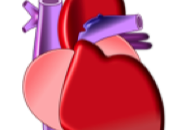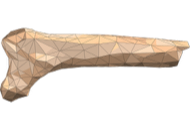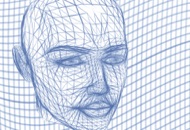RESEARCH AREAS
Bioingénierie Tissulaire (BioTis)
Inserm U1026
Université Bordeaux
146, rue Léo-Saignat
33076 BORDEAUX cedex - France
Tél. : 33 (0)5 57 57 14 88
Fax : 33 (0)5 56 90 05 17
Biofabrication and bioprinting
At Biotis, Biofabrication and Bioprinting are used to target particularly challenging aspects of the design of tissue engineered bone and vascularized tissue. 3D printers have been around for decades and basically allow the additive layering of a material to achieve a desired volume, which is based on a well-define numerical representation of the target tissue
In recent years, these printers can be used for medical applications to prepare a surgical procedure (make models), or even to produce custom-made pieces of biomaterials that will perfectly fit a patient's defect. Hence, surgeon can produce surgical models in resin to plan less invasive procedures. For these applications, stereolithography is often favored but Fused Deposition Modeling (FDM) can also be used. In addition, by taking advantage of current medical imaging technology, custom-made implants can achieve a better fit with the remaining tissues, which can lead to a more rapid healing process and a better outcome. Specific extrusion printers can be used to form various polymers or calcium phosphates.
More recently, 3D printers have been specifically designed to assemble biological components (Bioprinters) in many groups around the world including at BioTis. The three principal bioprinting approaches share some basic elements: 1) use of a “biological ink”, 2) printing is computer-driven based on a digital model, and 3) printing is performed layer-by-layer. When choosing the appropriate printing technology, it is critical to identify the need resolution and the volume of tissue to be printed. Indeed, most high resolution printers have a limited flow rate and, consequently, cannot print large volumes of tissue. Inversely, high-volume printers will not reproduce fine details. As a result, combinational approach can be considered for project that require both volume and high resolution.
Laser-Assisted Bioprinting (Raphaël DEVILLARD)
Based on the development effort of Fabien Guillemot, BioTis was a pioneer in Laser-Assisted-Bioprinting (LAB) and has established the Unit in a unique position in the bioprinting community. Poeitis is a start-up that was launched recently from BioTis (poietis) and aims at commercializing various bioprinting applications. At BioTis, LAB is used for its ability to very finely positions cells of various types in order to understand how to develop a vascular system with in tissue-engineered constructs in vitro. The proper distribution of capillary structures within tissue-engineered products is a challenge in many fields of tissue engineering to allow successful transplantation of thick tissues. LAB is also a technique of choice to pursue direct bioprinting at the site of the defect (in situ) and is an application actively under development at BioTis. We have designed a device specifically for this application (LASIT “Laser pour l'Ingénierie Tissulaire”), which was developed in collaboration with a local company (Novalase). The second generation of laser-based bioprinter (Modulab) uses a femtosecond laser and new software developed in collaboration with ALPhANOV and is currently located at the Poietis facility.
Extrusion-based Bioprinting (Raphaël DEVILLARD – Sylvain CATROS)
Bioimpression of hydrogels by extrusion is also performed at BioTis using a new printer developed in collaboration with the Bordeaux University Technology Institute (IUT), as part of a collaborative program of the Bordeaux Consortium for Regenerative Medicine (BxCRM). The development of hydrogels is performed in collaboration with the Unité 829 (“Université de Bordeaux”). These new “bioinks” will have optimize rheological properties to allows the production of large-volume constructs with better mechanical properties. (Raphaël DEVILLARD).
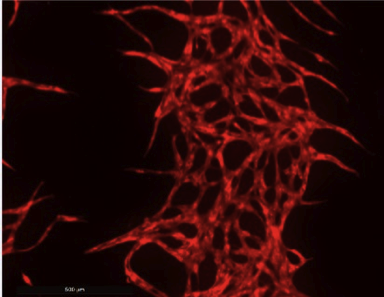
HUVEC network obtained by LAB
Fused Deposition Modeling (FDM) has been developed at Biotis thanks to a collaboration with the Technoshop from the Bordeaux University Technology Institute (IUT). A high-resolution FDM printer (Extrusion of wire of 50µm - 100µm) was developed to prepare support membranes (Biopapers) to build tridimensional constructs with cellularized multilayers. The « SANDWICH » project aims at following the evolution of tissue engineered bone constructs, produce by a layer-by-layer strategy, both in vitro and in vivo. The constructs are built from layers of PLA (polylactic acid) and mesenchymal cells isolated from adipose tissue (ANR funding: SANDWICH 2017-2020). After assembly of the cellularized layers, we hope to improve cell proliferation and differentiation in order to promote bone tissue formation, specifically for applications in oral and maxilla-facial reconstructive surgery. (Sylvain CATROS).
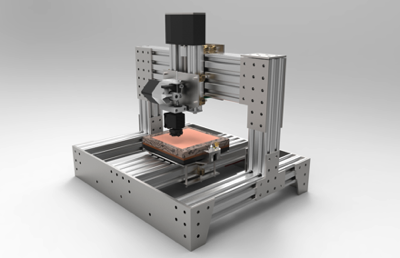
Microprint FDM bioprinter
A multi-modal printer commercially available has been recently added to BioTis tool set (3D Discovery, RegenHU®). This printer has 2 extrusion heads, 2 ink-jet heads and a photopolymerization system. This device will allow us to produce complex materials that combine relatively soft hydrogels with much harder calcium phosphates in order to produce advanced tissue engineered bone products for prosthesis pre-implantation oral surgery. (Sylvain CATROS).
Microfibers (Claire RIGOTHIER)
An innovative method to produce microfibers was developed at BioTis (patent pending). This technology allows the production of cellularized fibers of 100 µm that can be used for bone repair applications for instance. Other applications are under development and have been funded by "Agence de biomedicine" and "Aquitaine Science Transfert".
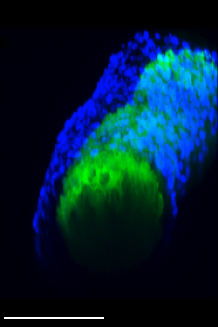
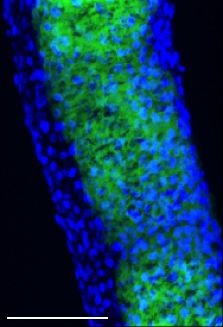
Microfiber with cells at day 21


